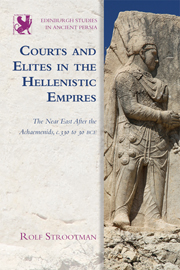Book contents
- Frontmatter
- Contents
- List of Illustrations
- Acknowledgements
- Abbreviations
- The Hellenistic Dynasties
- Series Editor's Preface
- Map
- Introduction: Court and Empire in the Hellenistic Near East
- PART I SETTING THE SCENE
- PART II THE COURT AS A SOCIO-POLITICAL SYSTEM
- 4 The Royal Household
- 5 Court Society
- 6 Royal Pages
- 7 Social Dynamics
- 8 Hierarchy and Conflict
- PART III CEREMONIAL AND RITUAL
- Conclusion
- Bibliography
- Index
8 - Hierarchy and Conflict
from PART II - THE COURT AS A SOCIO-POLITICAL SYSTEM
Published online by Cambridge University Press: 05 September 2014
- Frontmatter
- Contents
- List of Illustrations
- Acknowledgements
- Abbreviations
- The Hellenistic Dynasties
- Series Editor's Preface
- Map
- Introduction: Court and Empire in the Hellenistic Near East
- PART I SETTING THE SCENE
- PART II THE COURT AS A SOCIO-POLITICAL SYSTEM
- 4 The Royal Household
- 5 Court Society
- 6 Royal Pages
- 7 Social Dynamics
- 8 Hierarchy and Conflict
- PART III CEREMONIAL AND RITUAL
- Conclusion
- Bibliography
- Index
Summary
In the Seleukid and Ptolemaic kingdoms, the ranking of philoi in the court hierarchy was regulated and explicated by means of court titles and offices. In this chapter it will be argued that the distribution of titles was part of the complex of gift-exchange at court. Titles were presented by the king as gifts, comparable to, and presumably coming with, material gifts (clothing, crowns, horse trappings) so that the recipient would be able to show his rank to others and derive status from that. The institution of a more intricate system of court titulature after c. 200 BCE – first at the Seleukid and then at the Ptolemaic court – may have been an attempt to regain control of court society against the opposition of an established nobility of rich, land-holding philoi with hereditary prerogatives at court. Court titles potentially regulated access and relative status at court. Of the highest importance for kings was regulating access to the circle of royal advisors, the sunedrion. Another instrument to regulate access, discussed at the end of this chapter, was the promotion of a favourite: a loyal outsider who had direct access to the king and served as a protective shield between king and court society.
- Type
- Chapter
- Information
- Courts and Elites in the Hellenistic EmpiresThe Near East After the Achaemenids, c. 330 to 30 BCE, pp. 165 - 184Publisher: Edinburgh University PressPrint publication year: 2014



